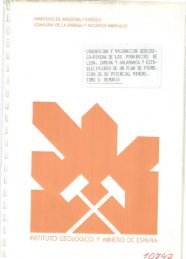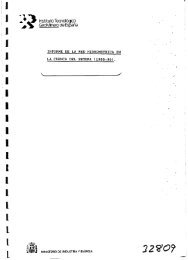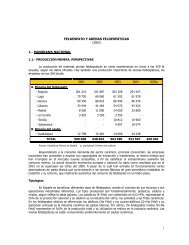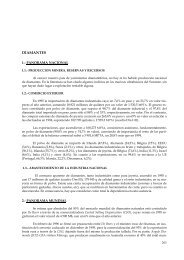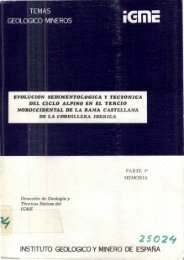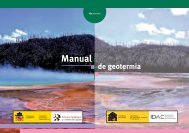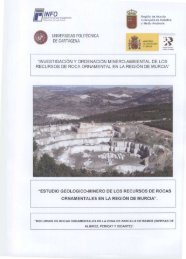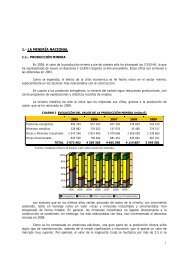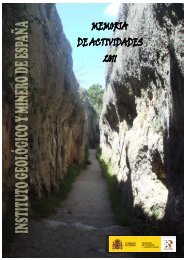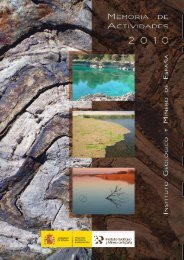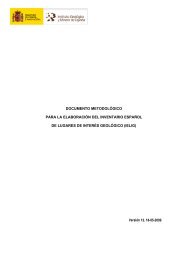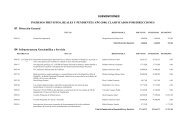6. Rotational kinematics of the Boltaña anticline - Instituto Geológico ...
6. Rotational kinematics of the Boltaña anticline - Instituto Geológico ...
6. Rotational kinematics of the Boltaña anticline - Instituto Geológico ...
Create successful ePaper yourself
Turn your PDF publications into a flip-book with our unique Google optimized e-Paper software.
<strong>Boltaña</strong> <strong>kinematics</strong> Mochales, 2011<br />
Relative deeper siliciclastic sediments evolving towards deltaic facies (Yeba Fm, Van Lunsen, 1970)<br />
conformably overlie <strong>the</strong> previous carbonate shelf. In <strong>the</strong> core <strong>of</strong> <strong>the</strong> <strong>Boltaña</strong> <strong>anticline</strong>, this unit<br />
includes a lower member with marls, siltstones and bioturbated sandstones and an upper member with<br />
bioclastic sandy limestone bed followed by two shallowing-upward sequences <strong>of</strong> marls, siltstones and<br />
sandstones. The entire Yeba Fm probably represents an important paleogeographic change to a more<br />
pronounced control in <strong>the</strong> foreland margin sedimentation by <strong>the</strong> orogenic geometry (Barnolas et al.,<br />
2011). The Yeba Fm includes <strong>the</strong> Ilerdian-Cuisian boundary (Mochales et al., 2011). The thickness <strong>of</strong><br />
this unit is difficult to measure due to <strong>the</strong> transitional character <strong>of</strong> its upper part; an estimate <strong>of</strong> 170 m<br />
has been found for <strong>the</strong> entire Yeba Fm in <strong>the</strong> Ara River section (Figures 3 and 4).<br />
Cuisian: The second main carbonate platform in <strong>the</strong><br />
Eocene (Barnolas et al., 2011) corresponds to <strong>the</strong><br />
<strong>Boltaña</strong> Fm (Barnolas et al. 1991), Early-Middle Cuisian<br />
(Ypresian) in age, 550 m thick in <strong>the</strong> Ara River section<br />
(Mochales et al., 2011). Barnolas et al. (1991)<br />
differentiated three units: lower and upper <strong>Boltaña</strong><br />
members separated by a double level <strong>of</strong> limestones with<br />
abundant Assilina (Ascaso Mb <strong>of</strong> Van Lunsen, 1970)<br />
indicative <strong>of</strong> a marine transgression (Barnolas and Gil-<br />
Peña, 2001). The lower <strong>Boltaña</strong> Fm corresponds to a<br />
mixed shelf (siliciclastic and shallow carbonatic)<br />
cropping out in <strong>the</strong> <strong>Boltaña</strong> and Mediano <strong>anticline</strong>s. It is<br />
made up <strong>of</strong> shallowing-upwards sequences with<br />
siliciclastic base (marls, siltstones and cross bedded,<br />
bioturbated sandstones) including Assilina, Nummulites<br />
and Discocyclina whereas its top is shallower, formed by<br />
sandy limestones with abundant Alveolina. The upper<br />
<strong>Boltaña</strong> Fm presents progressively deeper, shallowingupward<br />
sequences, acquiring <strong>the</strong>refore a retrogradational<br />
character (Barnolas and Gil-Peña, 2001). Its top contains<br />
distal ramp carbonates with abundant slump scars and<br />
micritic limestones (Figures 3 and 4).<br />
Figure 3. Simplified stratigraphic log where <strong>the</strong> main units<br />
dealt in this work are distinguished.<br />
35



